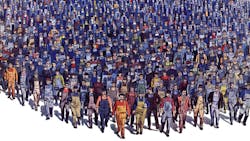Many a company has a "customer first" approach, and improvement methodologies such as Lean and Six Sigma start with the "voice of the customer" (VOC). So what is the point in trying to solve modern-day business problems with ethnography methods that many people still exclusively associate with anthropology?
Thanks to ethnographic studies, the Indian company Godrej & Boyce was able to develop the Chotukool fridge, a highly successful device that responds to the specific needs of people in rural India.
Intel, Whirlpool and Citigroup have professional ethnographers on their payroll. Procter & Gamble developed the Swiffer home-cleaning solutions through ethnographic studies.
The computer mouse, and the windows it helps navigate through, were also developed this way. If one day the computer mouse is made obsolete, that development work also will likely be inspired by ethnographic research.
We are convinced: Your company is missing an opportunity if ethnography is not among your methodologies to gather insight.
Learning to See Opportunities
Imagine you are the manager of the train station in Cologne, Germany. Your main concern is to make the beginning, middle and end of people's journeys a seamless experience. Gemba walks are part of your daily management routine. What you and your teams need for these walks are "glasses" for spotting opportunities to improve the travelers' experiences.
On today's walk, you see a man disembark from a taxi. The luggage still has the airport slip on, IEV -- CGN. Quite likely, he has flown into Cologne from Kiev Zhulyany (IEV) in Ukraine, and you decide to call him "Maxim." Visibly, Maxim does not understand German. You resist asking how you can help and follow as he wanders into and through the train station: Indeed, there are no signs saying "Tickets." "How odd," you think as you begin seeing the world through the eyes of what ethnographers call an "extreme user."
In the main hall, Maxim finds the information desk but struggles with queuing. In the middle of the hall, security forbids putting up any crowd control stanchions. So queues organize themselves, often chaotically. People also push the luggage with their feet as they advance. Some seem to worry about pickpockets. "No need," you think, since the police-raid two months ago.
The information clerk rightly points Maxim to the ticket counter. With the many people waiting for their turn, Maxim asks for help and is sent over to the ticket vending machines. You queue right behind him to see what happens next.
At his turn, Maxim pulls out a sheet of paper: "Titisee Neustadt." "So that's where he wants to go," you think, "a nice lake in the Black Forest." You see him struggle with the menu and call the software some names. Bending over a bit, you see Maxim type in "Neustadt," but oddly, while the software provides a good handful of options, "Titisee Neustadt" is not among them. Instead, Maxim chooses "Neustadt an der Aisch," a place deep in Bavaria, hundreds of kilometers from where he plans to go! The menu then tells him he is "missing a connection" with the first displayed option. Maxim rightly figures he should select the second option -- that is, if he actually wanted to go to Neustadt an der Aisch. The software asks a few more questions that Maxim wordily acknowledges. You stop him, though, when he is about to pay for the ticket: "Can I help?"
After directing Maxim to the correct ticket, you let him walk out and follow at a good distance, only to see him wandering again. "What is he looking for?" Finally, he passes by the bathrooms, walks around the corner, comes back -- and then walks in. The only sense you can make out of this is that Maxim struggled to see the little yellow "WC" signs. From the direction he was first walking, it is easy to miss the men's room, which he saw only on his way back.
Ethnography Is an Inductive Field Research Method
Let us first point out that this narrative at best gives a flavor for how ethnographers can help organizations unveil opportunities. There is a solid body of knowledge, enough for students to follow MSc University classes on "Design Ethnography." For an introduction, you may want to consult Designing and Conducting Ethnographic Research (Altamira, 2010).
Ethnography is a field research method developed in anthropology and social sciences. It relies on personal experiences, observation, collection of documents and artifacts, interviews, formal and informal conversations -- all of which support the "telling of a story."
Ethnography does not start with a hypothesis or a model that the researcher will then try to invalidate and accept as "useful" if he or she fails to do so. Rather, the output of ethnographic research is a frame, pattern or trend that allows putting the vast amount of gathered information into a meaningful context. Sound ethnographic research may require a trained and eventually certified professional. Practitioners also emphasize the need to "give yourself sufficient time" for such studies.
While ethnography is an inductive method, its output can be used for further quantitative deductive research, such as surveys and statistical analysis.
Given that the object of ethnographic research is human behavior, there are several schools of thought. That diversity has implications on the methodologies researchers suggest and how they are applied. It seems, though, there is agreement on the following features of ethnographic research:
- The focus is usually a relatively small scale investigation; it can be a single individual.
- The analysis of the data involves the interpretation of meanings and functions.
- The approach to data collection is mostly "unstructured" and "informal."
- The results of such analysis often are verbal descriptions.
- The research is conducted in people's everyday contexts.
- Data is gathered from a broad range of sources.
The inductive nature of ethnographic research also implies there can't be a detailed plan with pre-defined categories set up at the beginning of the investigation. This does not mean the research is unsystematic. On the contrary, a high amount of discipline is often required to make it successful.
Researchers will need to master the art of striking the balance between observation and collection on the one hand and participation and interaction on the other hand. These insider-results will then need to be translated into insight that is also accessible to outsiders -- hence the narrative approach to compiling findings and their interpretation.
Ethnographic Research and the Front End of Development
The front end of innovation is often perceived as unpredictable. There is, however, a systematic approach to handling that challenge.
We have come to appreciate the power of ethnographic research namely when it comes to defining an innovation opportunity and demonstrating how the solution addresses people's needs.
Ethnographic methods can uncover trends, attitudes and lifestyle factors that are relevant for consumer buying decisions. They help innovation teams tap into community and user knowledge, both explicit and tacit, which otherwise might not be available. Such insights can then be used for product or service design.
In our experience, the following innovation thinking and tools are very useful in shaping such research:
- Job to Be Done: a solution-neutral description of what consumers are trying to get done. Example: Buy my train ticket to my destination.
- Outcome Expectation: a solution-neutral description of what matters to consumers while they are getting the job done. Example: Maximize the ease of buying the ticket.
These are only two out of many tools that can help innovation and design teams ask the right questions and be receptive to relevant details during their field research. For how these tools can be applied and how they work together in the frame of an innovation project, The Innovator's Toolkit (Wiley, 2012) is a useful resource.
For each of the steps on a job map, there are multiple "Outcome Expectations." Frequently, they are driven by safety, ease of doing, quality, speed, cost and flexibility. As an example: "minimize the likelihood of having my luggage stolen while I am buying my ticket."
As the Cologne station manager, back in your office, these 15 minutes of observation and interaction would have helped you, together with tools such as a job map and Outcome Expectations, to capture your understanding of where your station is fundamentally failing to help people get their most fundamental jobs done.
Such a first "graph" of the people ("ethnos") you observed would allow you to conduct further such research, more focused for example on what matters to people while buying a ticket or getting to the bathroom. What we are saying here: When unfolding ethnographic research to identify opportunities for new and better ways to design products or services, you may play a "catchball" game between narrative and "graph" and researching people's behavior.
It Takes Practice, Commitment -- and Stomach
Ethnography provides a scientific toolset for reliable, repeatable, reproducible information collection. It takes practice to avoid mistakes and to overcome difficulties. The following are the challenges we have seen as most relevant in our studies:
- Collect information "broadly" and keep focused on the purpose of the investigation.
- Carefully select the right (mix of) approaches for any given investigation.
- Take care not to influence the object of research ("Hawthorne effect").
- Keep separate information collection and information interpretation.
- Cross-validate the information gained from different sources.
- Select wisely your informants and the "settings" of research.
- Use an individual's original language, not your language.
- Gain trust among the people involved in the research.
- Gather information from different perspectives.
Because of these challenges, ethnography can't simply be "introduced" to your company. To unfold its full potential and in order to have impact, it needs to be "deployed" and the associated change will need to be managed. Often times, that is associated with a journey starting from strategic objectives and ending with the company's approach to decision making. It might, therefore, not be easy to catch that train full heartedly. But we believe it's more than worth it.
Michael Ohler, Ph.D., is a principal at BMGI, with more than 20 years of experience as a scientist and performance professional. He is a certified Lean Six Sigma Master Black Belt and Kirton Adaption-Innovation Facilitator, as well as an innovation expert.
Phil Samuel, Ph.D., is BMGI's chief innovation officer. He has more than 20 years of technical and management experience and is a frequent speaker and author on the topics of innovation, strategy and performance improvement.
Mark McMurray, with more than 14 years of experience, is a senior client partner with BMGI, working with organizations to develop and deploy strategic plans. Mark has a master’s degree in operations management, and is a certified Lean Six Sigma Master Black Belt.



